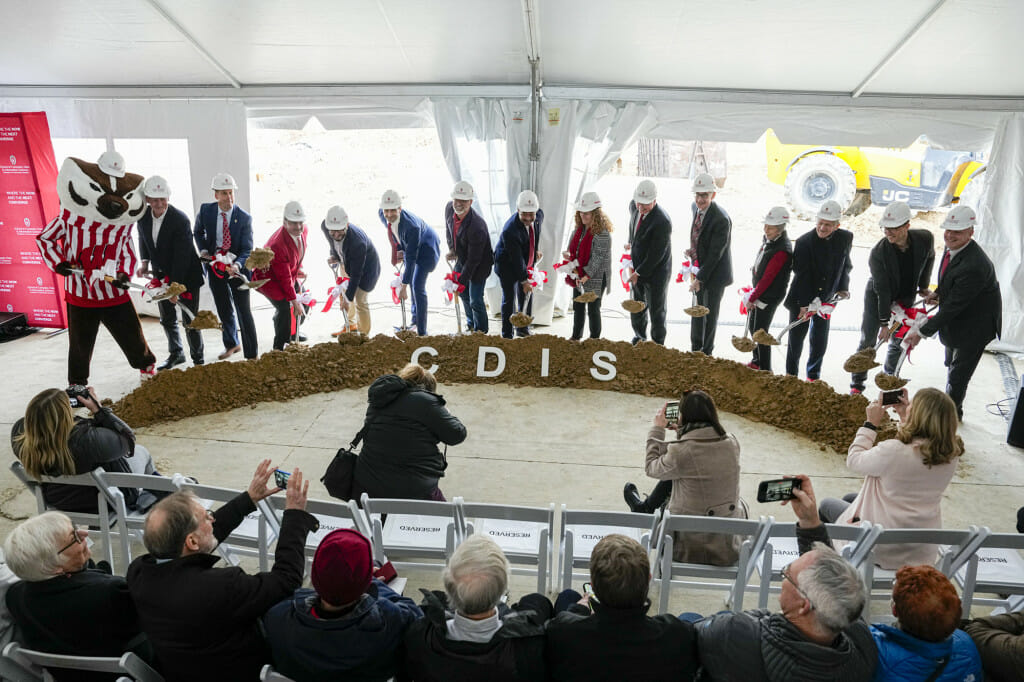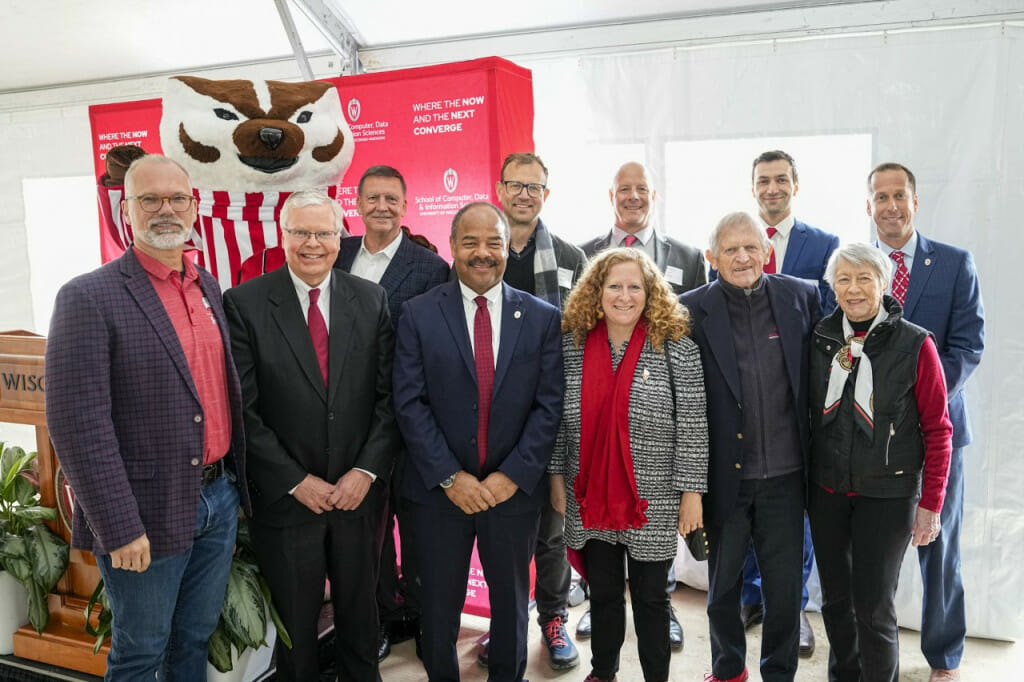Groundbreaking: CDIS building to foster high-tech innovation, collaboration

Dignitaries break ground on the new CDIS building on Tuesday, April 25. Photo by Andy Manis
In 1957, newly commissioned 2nd Lt. John Morgridge was installed at a Dover Air Force Base tabulating center alongside the latest in computing technology: a 25-ton, 6,000-square-foot Honeywell DATAmatic 1000.
How things have changed, said Morgridge, considering the future as he spoke on the construction site for the future home of the University of Wisconsin–Madison’s School of Computer, Data & Information Sciences. Many of the crowd gathered Tuesday for the building’s ceremonial groundbreaking carried more computing power than the DATAmatic 1000 in the tiny smartwatches on their wrists.
Expect a future that develops even faster, he predicted, with the CDIS building as an important nexus.
“Thousands of young minds walk its halls, occupy its labs, sit in its classrooms,” said Morgridge, who joined his wife Tashia as the principal donors supporting the construction. “Their assignment is to use data and data tools — many of which they will design — to understand and impact some of humanity’s most pressing problems: climate, disease, energy, waste, artificial intelligence and space, just to name a few.”
Gov. Tony Evers, UW System President Jay Rothman, Chancellor Jennifer Mnookin, Interim Provost Eric Wilcots and Tom Erickson, founding director of CDIS, offered their thanks to the Morgridges and Wisconsin Alumni Research Foundation for their investments in the building at the groundbreaking, also honoring the members of the UW–Madison community and design and construction professionals who will make the nearly 350,000-square-foot structure a reality over the next two years.
When it is completed, the building will house CDIS — which includes the Information School and the departments of Computer Sciences and Statistics — the UW School of Medicine and Public Health’s Department of Biostatistics & Medical Informatics, the American Family Insurance Data Science Institute, the N+1 Institute and the Center for High Throughput Computing.
“The partnerships that have already developed here with leading industry and area employers will ensure that students will be prepared for the workforce and have countless opportunities available to them with their high-demand skills.”
Tom Erickson
“The CDIS building will be a beacon of innovation and collaboration,” said Erickson, “a lighthouse for high tech in Wisconsin, nurturing a diverse and inclusive tech community, enabling computational fluency across all disciplines, supporting trailblazing research, cultivating entrepreneurs and attracting businesses to a highly skilled workforce.”
Evers expects the building and school’s influence to stretch far into the Wisconsin’s future.
“The partnerships that have already developed here with leading industry and area employers will ensure that students will be prepared for the workforce and have countless opportunities available to them with their high-demand skills,” he said. “And that’s why as a state, creating a pipeline of students with programs like this will be critical to growing a future workforce and cultivating visionaries that will build the future that we all want for our state and the world.”
The state’s higher education institutions are rising to the challenge, according to Rothman, with the flagship campus’s commitment as an example.

Those helping break ground for the new CDIS building included, left to right in the front row, Erik Iverson, CEO of the Wisconsin Alumni Research Foundation; UW System President Jay Rothman; Interim Provost Eric Wilcots; Chancellor Jennifer Mnookin; and John and Tashia Morgridge, the principal donors. Back row from left, Bucky Badger; Tom Erickson, CDIS founding director; Stephen Van Dyck, LMN architect and partner; Jeff Piette, Kahler Slater vice president; Bo Muwahid, Facilities Planning & Management project manager; and Jim Yehle, president and CEO of Findorff. Photo by Andy Manis
“Wisconsin can be proud that this new facility will allow this university to remain competitive, as well as provide a vehicle to collaborate with other system universities throughout the state,” Rothman said. “The UW System currently produces more than two-and-a-half times the graduates in computer and information sciences that we did just a decade ago. And UW–Madison is leading that way, more than tripling its graduates in this area.”
The university has been able to keep wildly popular degree programs in computer science (largest on campus) and data science (the fastest-growing major) open to all UW–Madison students who want in.
“This reflects our commitment to access, that all students should have the opportunity to incorporate computational thinking, data and information in their education,” said Wilcots. “That is the Wisconsin way, and that separates us from our peers in very important way.”
Mnookin announced that the new building’s student commons will be named for late Chancellor Emerita Rebecca Blank, “a person who believed deeply in the idea that to do truly amazing things you have to first bring people together,” Mnookin said.
The new home for CDIS, UW–Madison’s newest school, is a way to foster collaboration, multiplying the impact of technology across the university’s many deeply talented academic disciplines.
“This facility is going to allow us to do something that no other university in the country is doing — to bring together three top-ranked departments under one roof and anchor them in a high-tech corridor that links computing to biomedical research to engineering to medicine,” Mnookin said. “We know that to solve problems out in the world we need to work across. To build not just partnerships, but entire innovation ecosystems that draw in partners from all over campus and beyond to ignite groundbreaking discoveries and innovations that are going to change lives and power this state’s growing tech sector.”

Bucky Badger stands in front of the construction site of the new CDIS building. Photo by Andy Manis
